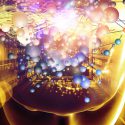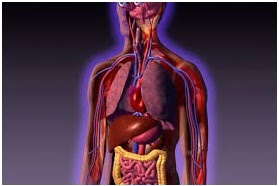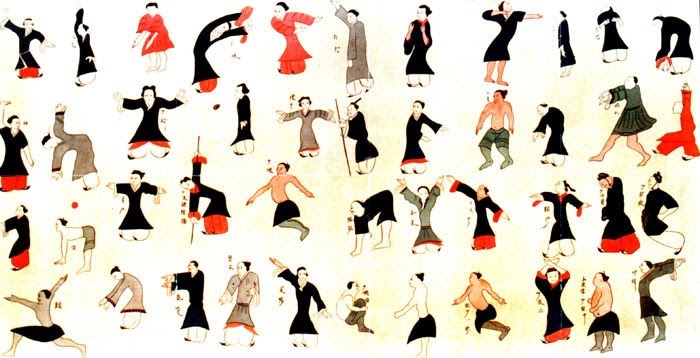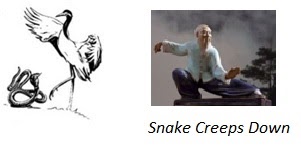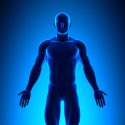What Is Yin Yang?
You may not know that the Yin Yang symbol we see everywhere is the symbol for Tai Chi or Taiji. It is not the martial arts Tai Chi, but it is called ‘Tai Chi’ and this symbol represents perfect balance. Yin and Yang are two polarized forces not to be confused with good and evil. Neither force is considered superior or inferior to the other. Yin and Yang are two forces within all and balancing these two forces is a key objective in Tai Chi and Qigong practice and in Chinese medicine. Yin typically represents; internal, cooling, retracted, feminine, etc. and Yang typically represents external, warming, expanding, masculine, etc. So a person who has too much Yin qualities will have an imbalance and a person with too much Yang qualities will have also have an imbalance. If you look at life, we all already understand this to some extent but from a different language. Someone who overworks, or talks excessively, thinks excessively, who is outward, pushing, and expanding is likely imbalanced toward Yang. It does not mean that they express negative qualities, only that it may be an imbalance in the mind and body. By the same token, someone who is overly reserved, shy, excessively internal, someone who does not initiate, may be considered to be imbalanced toward Yin. Again, this may be a wonderful person, however there is still an imbalance. Yin and Yang manifestations could be expressed in a multitude of character, physical and mental attributes of person, above is only one example. No one is perfectly balanced with Yin and Yang, so balance is constant evolution. The same applies to everything else, not just the human being, but all matter, situations, and more. In life there are infinite combinations of Yin and Yang expressed within everything. From this perspective, life is about balance, and as long as we exist, there are lessons and experiences we go through to learn and develop greater balance of Yin and Yang in our life.
Where Does Yin & Yang Come From?
Tai Chi, the state of opposites or Yin Yang, came into form from Wuji. Wuji is a formless state that existed before Tai Chi (Yin Yang). It may also be considered the state of Oneness. In other terms, Wu Chi has been stated to mean; “What there was before the Universe came into being”.
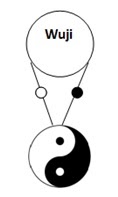 Tai Chi is what lies within shapes and features; Wuji is what lies beyond shapes and features (form). If Tai Chi sprang from Wuji, we can conclude that Tai Chi is a blend of Wuji (Formlessness), and a blend of Form. Together Wuji and Form make Tai Chi. Also referred to as Yin Yang.
Tai Chi is what lies within shapes and features; Wuji is what lies beyond shapes and features (form). If Tai Chi sprang from Wuji, we can conclude that Tai Chi is a blend of Wuji (Formlessness), and a blend of Form. Together Wuji and Form make Tai Chi. Also referred to as Yin Yang.
My personal understanding of this concept is that Wuji contains all Yin and Yang in the un-manifest, formless void of Oneness. In Wuji, separateness of the Yin and Yang forces is nonexistent, because it is a state void of polarity and even void of various shades of diversity. In this sense, there is un-manifest Yin and Yang yet there is no Yin and Yang existing in Wuji.
When Wuji became Tai Chi, Oneness in a sense split into “Two-ness”, Yin and Yang. From these two polarities of Yin and Yang, there sprang an infinite diversity of combinations of Yin and Yang forms. Each combination of Yin and Yang represented a unique aspect of the Wuji state.
The Bagua Represents The Infinite Yin and Yang Combinations:
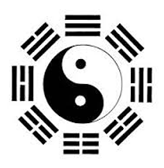 My best understanding of how Yin and Yang represents all form and all existence is through the Bagua (image above). In the Bagua, there are eight primary aspects of Yin and Yang combinations displayed to represent the universe. The number 8 representing infinity which is unending is also displayed in the Bagua representing an infinite amount of forms. In these eight primary combinations of Yin and Yang, all qualities exist as displayed in each trigram.
My best understanding of how Yin and Yang represents all form and all existence is through the Bagua (image above). In the Bagua, there are eight primary aspects of Yin and Yang combinations displayed to represent the universe. The number 8 representing infinity which is unending is also displayed in the Bagua representing an infinite amount of forms. In these eight primary combinations of Yin and Yang, all qualities exist as displayed in each trigram.
When the Chinese refer to a splitting off into ‘ten thousand things’, I understand this phrase to imply an infinite number of variations that the eight trigrams can divide into. Thus from each of the 8 possible primary combinations of Yin Yang trigrams, there exist infinite combinations of Yin and Yang fractalized within each trigram stemming from each primary combination.
For Example:
- Within the calendar year of the Bagua, the eight trigram combinations have eight trigrams contained within each of them to make eight hexagrams.
- Not displayed in the Bagua design, within each hexagram there also exists a division of eight more trigram combinations and also eight more hexagram combinations.
- Within each one of those eight sub-trigrams and eight sub-hexagram combinations, these eight combinations continue within eight combinations infinitely, with infinite microcosms of Yin and Yang within each combination of Yin and Yang. Strangely, this implies the finite is also the Infinite, yet it is still not Wuji because it is still not Oneness.
- This example was just a representation of the calendar year. However, this same analogy of infinite microcosms of Yin and Yang could also be considered to exist within EVERYTHING outside of Wuji. Thus the infinite combinations of Yin and Yang can be applied throughout all aspects of creation.
- Further, by the same token, perhaps we can consider this same concept of infinite combinations of Yin and Yang to be applied to the macrocosm as well. Here Yin and Yang could exist in infinite combinations of collective combinations; of matter, of planets, of worlds, of celestial bodies, of universes, of dimensions, etc.
Thus the Bagua could be said to be a design of infinity, which represents the infinite combinations of Yin and Yang.
Perhaps it may also be stated that the Bagua represents the infinite diversity that sprang from Wuji. And the Bagua symbol can also be a method for understanding the transformation of Wuji to Tai Chi.
When it was finally brought to my understanding of how the Bagua trigrams and hexagrams were read, I suddenly realized that the Bagua represented the infinite creations of Yin and Yang in the sense as described above. I then began with more clarity to view and understand everything in existence in terms of Yin and Yang, from Tai Chi and Qigong including all other aspects of life. Often I have reflected that the purpose of life is Balance. Balancing the multiple combinations of Yin and Yang seems to be the purpose of life. My understanding is that through that balance, we become more like Wuji; when the balance of Yin and Yang in all aspects of our life comes into balance.
The lack of balance of Yin and Yang is the root of suffering, illness, discontent, and unhappiness. Tai Chi and Qigong help move us toward a state of balance of Yin and Yang which is closer to the state of Wuji. Also an emphasis in Tai Chi and Qigong is in effortless action, or ‘Wu Wei’, which is also the way of return to the state of Wuji, as Wuji represents an effortless state. Ironically, it takes discipline to act and move effortlessly, yet it is only the discipline of unlearning to return to our natural and effortless form that is taught in Tai Chi and Qigong practice.
In Tai Chi and Qigong practice, we focus on the balance of the Yin and Yang forces to bring the harmonious unison of these forces so we may become more like our original Wuji state.
You might say we are aligning our frequency to the wavelength of frequencies that are resonating with balanced Yin and Yang forces, which is more like Wuji. As we can resonate in tune with frequencies of balanced Yin and Yang, we can begin to return to Wuji.
Being that Wuji is formless and free of separation and our frequency is that of form and polarity; we use tools to recognize Wuji, our original self. The Art of Cultivation is the tool Qigong uses to recognize Wuji.
Return To Wuji – “Shen Ren” (Spirit Person):
- First we use the body to recognize the Qi. The art of cultivation is to use the body to recognize the Qi.
- We then recognize that Qi permeates all form.
- We then use the Qi to recognize Shen, or the Spirit.
- We then use Shen to recognize Wuji.
This is known as transformation of Jing to Qi to become Shen (Spirit) Ren (Man) (Shen Ren: return to Wuji).
Qi is thus a bridge for Ren (Man) to identify with Shen (Spirit). Qi may then be considered a force penetrating and interconnecting throughout Yin and Yang and thus permeating all of creation. If so, with the intent of our mind learning to recognize Qi in all, we can then begin to feel the Qi interconnected with our Shen and develop a greater bridge to our Shen.
Theory Of Shen and Wuji & Yin Yang
How does Shen configure into this concept of Yin and Yang and Wuji?
My best understanding of this question is that Shen is the infinite multitudes of unique aspects of Wuji in non-embodied form. Shen could thus be considered the “Higher Self” or the “Soul” or the Spirit unique to each form.
Based on the Bagua concept illustrated above; in the entire Ying Yang spectrum, everything in creation exists with some balance and combination of Yin and Yang. Since Shen is also a manifestation from Wuji, it too would have some combination of Yin and Yang.
Being that Shen is always represented as a Yang force in Taoist belief, Shen may then be represented as a Yin Yang symbol that is primarily white, or that of formlessness. Still, some minute portion of black or form would exist in Shen because nothing is pure Yang or pure Yin for that matter. Thus Shen would have some combination of Yin and Yang, however its shade being primarily white. These combinations of Yin and Yang that exist would be infinite and completely unique even though each Shen would be primarily Yang in its composition. Using the Bagua concept, each Shen could be considered a mathematical composition of entirely unique Ying and Yang combinations.
Shen could be considered an infinitesimal split from Wuji if we consider a pure force to represent Oneness. Being that Shen is not 100% Yang and thus not a 100% pure force, it has some degree of form, considering Yin represents form. With this concept, an infinitesimal separation of pure Oneness still remains within each given Shen.
Taking the concept of Yin Yang and Newton’s 3rd law for that matter, every force would have an equal and opposite force. With this understanding, creation would seek to balance the spectrum of Yin and Yang equally. So each Shen would manifest the un-manifest Yin into existence to experience its polarity. Shen would seek to find balance of Yin and Yang through form. Shen could also manifest the variations of form that are primarily Yang in existence, yet with infinite shades of Yin and Yang across the spectrum. This provides Shen with the full experience of all creation and all of Yin and Yang. Because each Shen would come into beingness with some unique and minute shade of Yin, it would be unique in its experience and each experience of form that Shen manifests would be unique in its evolution. Shen would then gain experience of the balance of the entire Yin and Yang.
With this concept, we may perceive Shen existing multi-dimensionally in a broad spectrum of Yin Yang existence.
Part of the Yin manifestation or experience of Shen may take the form of Ren (Human) with existence on earth. As Ren progresses and gains experience of Yin and Yang balance, its soul or Shen gains this experience and it too balances toward perfection of Yin and Yang. From our linear perspective, our Ren (Human) experience may also causes us to regress in our balancing of the Yin Yang force taking us away from our Shen’s purpose (Li) of balancing the Yin and Yang aspect of itself. We can become imbalanced toward the direction that our free will takes us, which could cause imbalances in either Yin or Yang development. The Shen then manifests additional forms or lifetimes to bring balance to the imbalance that has occurred.
Ren (Human), is the combination of Yin and Yang force; thus we cannot exclude the existence of our Yang Shen or Earth (Yin) in our experience. In the human form we may draw toward either polarity, however we are seeking balance of the Heaven and Earth forces. Since our Shen is our unique spirit aspect of ourselves, recognizing our Shen becomes extremely important in understanding our purpose (Li). Our Shen carries our purpose (Li) of our existence. Ironically, when we are tuned into our Shen, we also understand how to gain balance with the Yin force, because our Shen drew us toward this experience with Yin. My understanding is that we bring our unique Shen into our experience on earth, learning to balance our Shen in equal harmony with earth. Because Shen is like Wuji and yet not Wuji and because it is our unique aspect of Wuji directly linked to each one of us, we become closer to Wuji consciousness by first recognizing our own Shen or soul. Shen could thus be considered a very personal connection or conduit to Wuji since our own Shen is unique to our own being.
When we have perceived this concept of Shen and Yin and Yang as infinite aspects of Wuji, then we may understand that only all of creation combined together makes up the full and complete Yin and Yang balance. Yet, none of creation individually makes up a perfect Yin Yang balance. With this understanding, growth toward Wuji is infinite because the degrees of balancing Yin and Yang are infinite. Without discouragement, the pure state of Wuji is never experienced however near to Wuji that form maybe, unless Wuji were to withdraw Yin and Yang back to Oneness. Being that all is Wuji anyhow, ‘We’ (Wuji) exist in multiple forms. ‘We’ (Wuji), have chosen to understand separateness and non-oneness in its infinite forms and to experience the return toward Wuji. With this concept, absolute perfect balance of Yin and Yang never exists except as the entire collective of all existence. Absolute perfect balance of Yin and Yang would in fact be Wuji yet the perfect Yin Yang also would not be Wuji because polarity does not exist in Wuji. In a sense, there is no Wuji to reach yet all is Wuji and to reiterate; all creation together represents the absolute perfect Yin Yang, and it is all Wuji.
Since we are all One, as any part of the One changes, we all change because the full spectrum of balance adjusts the entire Yin Yang of the universe maintaining that balance accordingly. Thus all aspects of the Ying and Yang force are ever changing.
Summary
In conclusion of all expressed in this essay, I have come to have a clearer understanding of the entire universe and how Taoist concepts fit into this portrait.
I have understood that Wuji splitting into Yin Yang makes perfect sense. To consider that the entire universe is all Wuji with an infinite diversity of Yin and Yang combinations clarifies the order and structure of Infinity.
Thinking of the entire creation as a whole, making up an absolutely perfectly balanced Yin Yang, brings understanding of this symbol to represent profound significance along with the basic understanding of the Bagua and the trigrams representing all combinations of existence.
Through basic understanding of the Bagua, came the intellectual realization that everything in existence contains all of the eight trigrams and sub-trigrams combined as an infinite multitude of codes for each and every form. This may be termed the ‘energy signature’ of each form.
When I ask myself how Shen fits into the picture, I could only comprehend that Shen or the soul is a sliver of differentiation from Wuji; however within that small sliver exists infinite souls (Shen).
Within that sliver of non perfection, there exists an infinite combination of trigrams and hexagrams. Each unique combination makes up each soul (Shen). Each soul is very much like Wuji’s state of perfection yet not of pure Wuji. Shen being primarily Yang, seeks to gain balance of Yin and Yang through multitudes of forms. Our human form in turn, seeks to gain balance of Yin and Yang in alignment with Shen’s purpose.
With this understanding, we may understand that the purpose of creation is to arrive toward that perfect balance of Yin and Yang.
With this understanding and this purpose, we may seek to practice Tai Chi or Qigong to achieve that balance.
Through these practices, we can break through conditional thinking that has brought imbalances. These practices are designed to bring balance to the Yin and Yang forces within us. Developing awareness and becoming more like the Wuji force within us, we act less from the conditioned mind.
The first step in developing Wuji consciousness is to recognize the Qi within ourselves and in all form and use that Qi to recognize the Shen. The Qi permeates both Earth and Heaven and man, so the Qi is the connective link for recognizing Shen (Spirit). Shen could be considered like a “Little Wuji” specific to each being so that each being can connect to Wuji through their Shen, their personal aspect of Wuji.
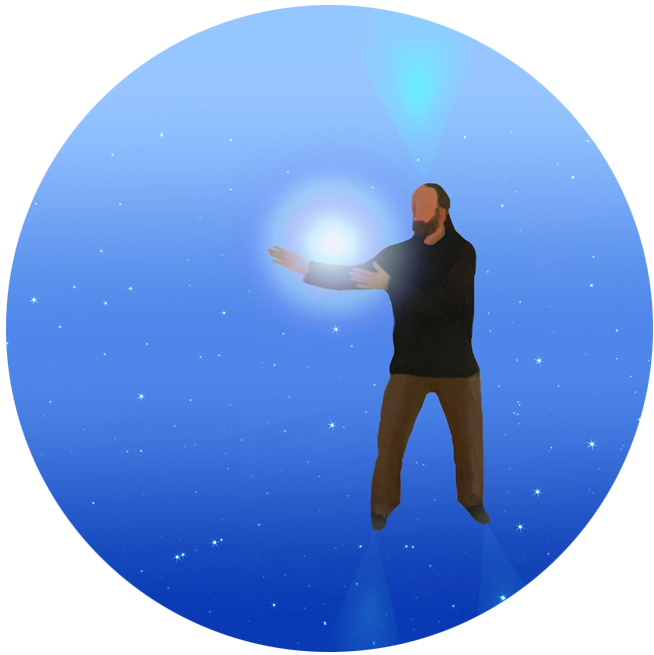


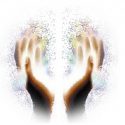

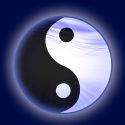

 Tai Chi is what lies within shapes and features; Wuji is what lies beyond shapes and features (form). If Tai Chi sprang from Wuji, we can conclude that Tai Chi is a blend of Wuji (Formlessness), and a blend of Form. Together Wuji and Form make Tai Chi. Also referred to as Yin Yang.
Tai Chi is what lies within shapes and features; Wuji is what lies beyond shapes and features (form). If Tai Chi sprang from Wuji, we can conclude that Tai Chi is a blend of Wuji (Formlessness), and a blend of Form. Together Wuji and Form make Tai Chi. Also referred to as Yin Yang. My best understanding of how Yin and Yang represents all form and all existence is through the Bagua (image above). In the Bagua, there are eight primary aspects of Yin and Yang combinations displayed to represent the universe. The number 8 representing infinity which is unending is also displayed in the Bagua representing an infinite amount of forms. In these eight primary combinations of Yin and Yang, all qualities exist as displayed in each trigram.
My best understanding of how Yin and Yang represents all form and all existence is through the Bagua (image above). In the Bagua, there are eight primary aspects of Yin and Yang combinations displayed to represent the universe. The number 8 representing infinity which is unending is also displayed in the Bagua representing an infinite amount of forms. In these eight primary combinations of Yin and Yang, all qualities exist as displayed in each trigram.

